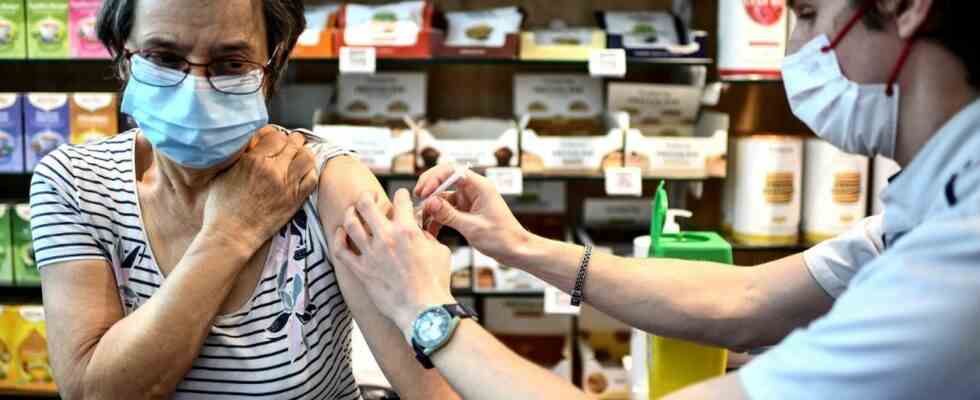Is the eighth wave of Covid-19 slowing down? In any case, this is what the indicators of the epidemic seem to show. Like the incidence rate, which “stabilized at a high level nationally after five weeks of increases”. This reference indicator for monitoring the evolution of the epidemic reported 567 cases per 100,000 inhabitants on October 17, according to the weekly bulletin published Thursday, October 20 by Public Health France. A figure certainly high but which stabilized before starting to decrease in recent days.
If the peak of contamination seems to have been reached (more than 53,000 daily cases on average over the last seven days), this eighth wave of the coronavirus continues however to send thousands of patients to the hospital (6,556 new hospitalizations the week of October 10) and in critical care (up 8% compared to the previous week). And Covid-19 continues to kill hundreds of people every week: 390 patients died the week of October 10, 23% more than the previous week. What are the lessons to be learned from this autumn wave? Franceinfo takes stock with epidemiologists.
The peak of contamination coincides with the start of the school year
We note, on the graph below, that the incidence rate of the Covid-19 epidemic started to rise again at the beginning of September. “The correlation is perfect with the start of the school yearpoints out epidemiologist William Dab, contacted by franceinfo. We saw the wave restart only a few days later.” The former director general of health cites several examples of measures that have been insufficiently implemented to curb this eighth wave: ventilation systems in closed places, at work or at school, or even the obligation to wear a mask in transport and closed places.
The rate of change in the number of contaminations since the beginning of September confirms the observation made by William Dab. There is clearly a sharp increase in cases (represented in red on the graph below) from the week following the start of the school year, which took place on September 1. “This is the result of an epidemic recovery mainly due to Omicron BA.5”, explains to franceinfo Mircea Sofonea, epidemiologist at the University of Montpellier. And this, because of two phenomena which reinforce the risk of contamination: “the immune decline and the fall season”. “AWith shorter and cooler days, the population increases its time spent indoors, where transmission is favored”explains the specialist.
This back-to-school wave could well end during the All Saints holidays, which begin on Saturday October 22 for the whole country. They have “in the past, slowed down the circulation of Sars-CoV-2”, says Mircea Sofonea. But we must not declare victory too quickly. An upsurge in cases could follow due to “school resumption, the spread of BQ.1.1 [un nouveau variant qui émerge en Europe] and the beginning of the winter season”warns the epidemiologist.
Fewer hospitalizations
The main lesson of this eighth wave is also good news: the number of hospitalizations over the period was “among the weakest” compared to previous waves, notes Mircea Sofonea. In “particular” regarding critical care admissions. A drop attributed to the vaccination coverage rate, which was, on October 17, 82.5% among people aged 65 and over, according to Public Health France. This lower number of hospitalizations “is a sign that vaccination protects well against serious forms over the long term”emphasizes Mircea Sofonea.
In addition to the vaccination rate, it is the spread of the Omicron variant that explains this reduced number of hospitalizations. “This is unheard of in epidemiology: at least 70% of people have an infection with Omicron. But we must not believe that it is over”warns William Dab. “Many large-scale studies have shown that the more infectious episodes we have with this virus, the more our thread of complications increases. In particular diabetes, myocardial infarction and cerebrovascular accidents”, underlines the epidemiologist. According to him, we must therefore get out of our heads the idea that Covid-19 is no longer dangerous because it would send fewer people to hospital immediately. “This virus will leave traces in the medium and long term. The more we can avoid being contaminated, the better.assures William Dab.
Less severely affected children
Other good news, on the children’s side: this eighth wave, mainly caused by the BA.5 sub-lineage of Omicron, has resulted in very few Pims, these pediatric multisystem inflammatory syndromes which affect certain children with Covid-19. “Five cases have occurred since the beginning of August”, French public health reliefin its bulletin published on October 20.
This sharp decline in the risk of Pims “could be explained in particular by a lower capacity forOmicron to trigger hyperinflammation“noted the authors of the American scientific journal Jama Pediatricsquoted in The Parisian. Another hypothesis: that the Pims “occur especially after a primary infection”advances Christelle Gras Le Guen, president of the French Society of Pediatrics (SFP), to the daily.
“In recent weeks, the evolution of the epidemiological situation in children under 18 has been characterized by a drop in incidence rates”, confirms for its part Public Health France. The number of pediatric hospitalizations due to Covid-19 has remained stable for a month. In the majority of cases, children under the age of 1 are hospitalized. The week of October 10, these toddlers represented 59% of hospitalizations for 0-17 year olds, and 48% of critical care admissions.

